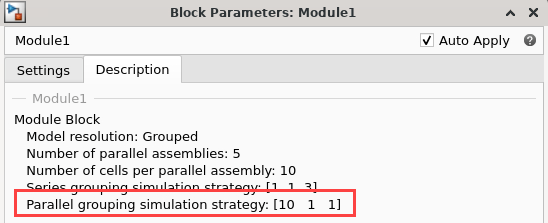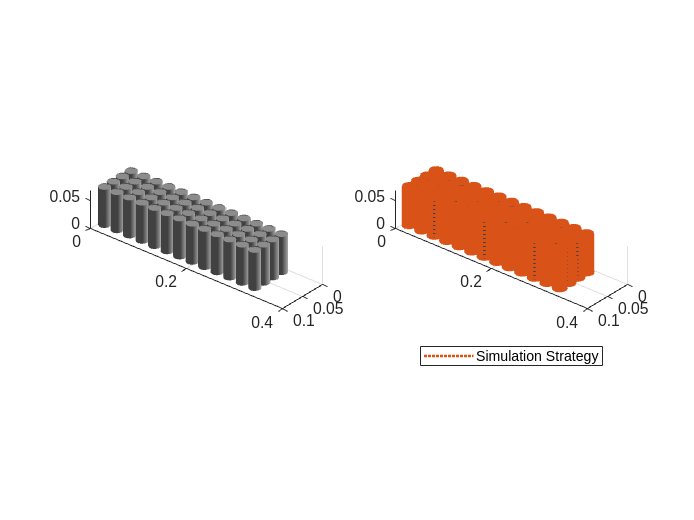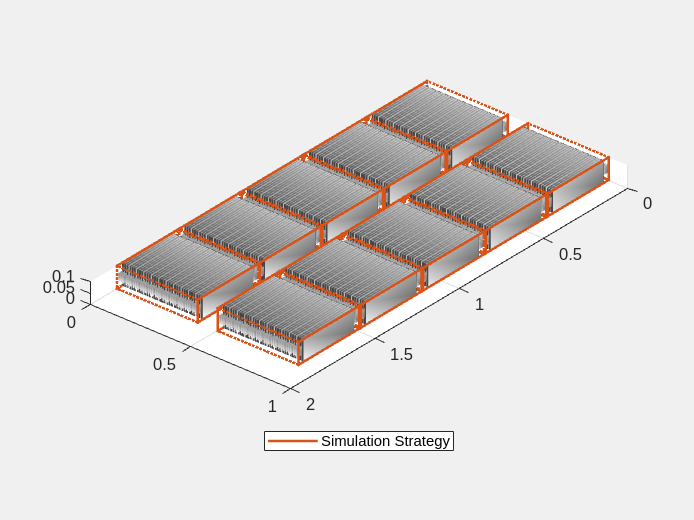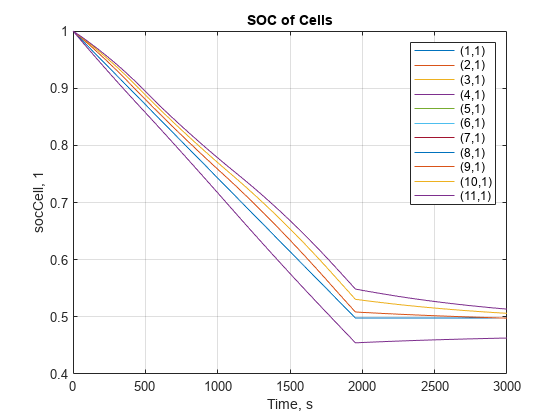Module (Generated Block)
Description
The Module block represents a custom generated system model of a battery module. You can
create this Simscape™ block by using the buildBattery
function with a Module object as
an input argument. The Module generated block is inside the Simulink library that you specify
in the LibraryName argument of the buildBattery
function.
Note
To allow for structural changes and further customization, when you add the Module (Generated Block) masked library block from the parent library to a Simulink® model, the linked block does not contain the link or path to the parent library block. If you modify any of the battery structural properties, such as NumSeriesAssemblies or NumParallelCells, you must rebuild the original parent library and copy the block in your model again.
For more information about parent and linked blocks, see Linked Blocks.
Variables
To set the priority and initial target values for the block variables prior to simulation, use the Initial Targets section in the block dialog box or Property Inspector. For more information, see Set Priority and Initial Target for Block Variables.
For a detailed list of the variables in the ParallelAssembly block, see the Initial Targets (Variables) section.
Note
The values of variables for cell-level components refer to the value of a single physical cell and not that of a cell model. (since R2023a)
For example, consider a parallel assembly with 10 cells in parallel and a lumped model resolution. The ParallelAssembly generated block exposes the variable v of the cell component as vCell. For a cell with a voltage of 4.2 V, vCell is equal to 4.2 V. Before R2023a, the generated blocks exposed the cell variables with the suffix CellModel and represented the variables of the entire model they represented. For example, using the previous ParallelAssembly generated block, the block exposed a vCellModel variable with a value equal to 4.2*10 = 42V.
Nominal values provide a way to specify the expected magnitude of a variable in a model. Using system scaling based on nominal values increases the simulation robustness. Nominal values can come from different sources, one of which is the Nominal Values section in the block dialog box or Property Inspector. For more information, see System Scaling by Nominal Values.
Examples
Build Simple Model of Battery Module in MATLAB and Simscape
Create and build a Simscape system model of a battery module with Simscape Battery™.
Build Simple Model of Battery Pack in MATLAB and Simscape
Create and build a Simscape system model of a battery pack with Simscape Battery.
Apply Parameter Variation to Cells in Module
Specify a parameter variation between the individual cell models in a battery block that you generate using Simscape™ Battery™ objects and functions. When you need a high-fidelity model of a battery, to achieve high accuracy, you must consider the deviations between individual cells. This deviation can be random, for example, due to manufacturing tolerances, or specific to individual cells, for example, if the state of health (SOH) varies between cells. The battery blocks that you generate with Simscape Battery support the specification of a variation in the parameters at different design levels.
- Since R2023b
- Open Live Script
Ports
Input
Cell balancing port, specified as a physical signal.
Dependencies
To enable this port, set the BalancingStrategy property of
the Module object to "Passive".
Alternatively, set the BalancingStrategy property to
"Passive" inside the parent object of which the
Module object is a subcomponent.
Output
Note
The output ports of this block depend on the Simscape cell model block you used to create the battery object associated with this block. If the Simscape cell model block has output ports, the Battery Builder forwards these output ports to all the parent generated blocks of which the battery object is a subcomponent.
For example, if you create a custom Simscape cell model block with a Voltage output port and
eventually use it to create this block, then this block has a Voltage
output port. For more information about custom cell model blocks, see the
CellModelBlockPath property of the CellModelBlock
object.
Since R2024b
State of charge at cell level, specified as a physical signal.
Dependencies
To enable this port, use the Battery (Table-Based) block as the component model
block for the Cell child object of this block and enable the
SOC port.
Conserving
Electrical conserving port associated with the positive terminal of the battery module.
Electrical conserving port associated with the negative terminal of the battery module.
Thermal conserving port associated with the ambient thermal path.
Dependencies
To enable this port, set the AmbientThermalPath property of
the Module object to
"CellBasedThermalResistance". Alternatively, set the
AmbientThermalPath property to
"CellBasedThermalResistance" inside the parent object
of which the Module object is a subcomponent.
Thermal conserving port associated with the coolant thermal path.
Dependencies
To enable this port, set the CoolantThermalPath property of
the Module object to
"CellBasedThermalResistance". Alternatively, set the
CoolantThermalPath property to
"CellBasedThermalResistance" inside the parent object
of which the Module object is a subcomponent.
Note
If you set the CoolingPlate property to either
"Top" or "Bottom" inside
the Module object or inside the top-level parent object of
which the Module object is a subcomponent, then this port is
not enabled.
Since R2024a
Thermal conserving port associated with the minimum X-axis surface boundary,
specified as an N-by-1 vector or a
scalar.
Dependencies
To enable this port, set the XminThermalNodes property of
the Module object to "Scalar" or
"Vectorized".
Since R2024a
Thermal conserving port associated with the maximum X-axis surface boundary,
specified as an N-by-1 vector or a
scalar.
Dependencies
To enable this port, set the XmaxThermalNodes property of
the Module object to "Scalar" or
"Vectorized".
Since R2024a
Thermal conserving port associated with the minimum Y-axis surface boundary,
specified as an N-by-1 vector or a
scalar.
Dependencies
To enable this port, set the YminThermalNodes property of
the Module object to "Scalar" or
"Vectorized".
Since R2024a
Thermal conserving port associated with the maximum Y-axis surface boundary,
specified as an N-by-1 vector or a
scalar.
Dependencies
To enable this port, set the YmaxThermalNodes property of
the Module object to "Scalar" or
"Vectorized".
Since R2024a
Thermal conserving port associated with the serpentine cooling plate boundary.
Dependencies
To enable this port, set the SerpentineCoolingPlate
property of the Module object to
"SingleSidedAlongStackingAxis" or
"DoubleSidedAlongStackingAxis".
Thermal conserving port used to connect the top side of the module with a cooling
plate. The size of this port depends on the number of models in the system. If you set
the ModelResolution property to
“Lumped”, this port outputs a scalar. If you set the
ModelResolution property to
“Detailed”, this port outputs a vector of size equal to
the number of cells in the system. If you set the ModelResolution
property to “Grouped”, this port outputs a vector of size
depending on the grouping strategy.
Dependencies
To enable this port, set the CoolingPlate property of the
Module object to "Top". Alternatively,
set the CoolingPlate property to
"Top" inside the parent object of which the
Module object is a subcomponent.
Thermal conserving port used to connect the bottom side of the module with a
cooling plate. The size of this port depends on the number of models in the system. If
you set the ModelResolution property to
“Lumped”, this port outputs a scalar. If you set the
ModelResolution property to
“Detailed”, this port outputs a vector of size equal to
the number of cells in the system. If you set the ModelResolution
property to “Grouped”, this port outputs a vector of size
depending on the grouping strategy.
Dependencies
To enable this port, set the CoolingPlate property of the
Module object to "Bottom".
Alternatively, set the CoolingPlate property to
"Bottom" inside the parent object of which the
Module object is a subcomponent.
Since R2024a
Electrical array-of-nodes conserving port associated with the positive terminals of the parallel assemblies inside this module. Each element of this array corresponds to a positive terminal of a parallel assembly inside this module.
Dependencies
To enable this port, set the BalancingStrategy property of
the Module object to "External".
Alternatively, set the BalancingStrategy property to
"External" inside any of the parent battery objects of
which the Module object is a subcomponent.
Since R2024a
Electrical array-of-nodes conserving port associated with the negative terminals of the parallel assemblies inside this module. Each element of this array corresponds to a negative terminal of a parallel assembly inside this module.
Dependencies
To enable this port, set the BalancingStrategy property of
the Module object to "External".
Alternatively, set the BalancingStrategy property to
"External" inside any of the parent battery objects of
which the Module object is a subcomponent.
Parameters
Note
The names of these parameters and variables depend on the block you have specified in
the CellModelOptions property of the underlying Cell
object that constitutes this module.
The names of the parameters and variables in this page refer to a Cell
object with the Battery
(Table-Based) block as the cell component model block. If you specify a
custom block for the cell component model, the names of the parameters and variables might
differ.
The parameters of this block need to be set for the cell-level and depend on how you
define the Module object that
you use to generate this custom model. The block parameters are divided into these sections:
Main
Dynamics
Fade
Calendar Aging
Thermal
Cell Balancing
The visibility of each section also depends on the generated Module
object.
For a list of the parameters in the Main, Dynamics, Fade, and Calendar Aging sections, see the documentation page of the Battery (Table-Based) block.
If, in the Module object that
you use to generate this custom model, you set the CellParameterDeviation
property to "PercentDeviation", each cell parameter (that is not an
enumeration or a boolean) has an associated Percent deviation
parameter:
Since R2023b
Percent deviation of the value of the corresponding cell parameter k for each cell model in the battery. k is the name of the cell parameter associated with this percent deviation.
The number of parameters of this type is equal to the number of cell parameters in this block. Parameters of type enumeration and boolean do not have an associated Percent deviation parameter.
The value of the corresponding cell parameter with the deviation applied is equal to:
For this parameter, you can specify either:
A vector, with one element for each cell model in the battery. These elements are concatenated vertically. For example, for a
Moduleobject with two parallel assemblies, three cells, and theModelResolutionproperty set to"Detailed", this vector requires six elements. For aModuleobject with theModelResolutionproperty set to"Grouped", the size of this vector depends on the number of cells modeled in the module. The number of modeled cells is equal to the sum of the elements of theParallel grouping simulation strategyproperty. You can find this property in the Description tab of the Property Inspector of the Module block.
A matrix, where each element of the matrix is either a scalar or a matrix of the same size of the underlying associated cell parameter. The parameter deviation elements are concatenated vertically. For example, if a cell parameter has a size of
[2,7]and a detailed parallel assembly comprises two cells, then the size of the Percent Deviation for this parameter is equal to[4,7].
For more information about cell-to-cell parameter variation, see the Apply Temperature-Dependent Cell Parameter Variations to Battery Module example.
Dependencies
To enable this parameter, set the CellParameterDeviation
property of the Module object to
"PercentDeviation".
Thermal
Thermal inertia of a single battery cell. This value represents the energy required to raise the temperature of the thermal port by one degree.
The Module block automatically scales this value up to the system level.
Resistance of the coolant thermal path at cell level. The size of this parameter is equal to the total number of electrical models in the system.
Dependencies
To enable this parameter, set the CoolantThermalPath
property of the Module object to
"CellBasedThermalResistance". Alternatively, set the
CoolantThermalPath property to
"CellBasedThermalResistance" inside the parent object
of which the Module object is a subcomponent.
Resistance of the ambient thermal path at cell level. The size of this parameter is equal to the total number of electrical models in the system.
Dependencies
To enable this parameter, set the CoolantThermalPath
property of the Module object to
"CellBasedThermalResistance". Alternatively, set the
CoolantThermalPath property to
"CellBasedThermalResistance" inside the parent object
of which the Module object is a subcomponent.
Since R2023a
Resistance of the thermal path between the cells inside the module. The size of this parameter must be equal to the number of inter-cell thermal connections that this block models.
Dependencies
To enable this parameter, set the InterCellThermalPath
property of the Module object to "On".
Alternatively, set the InterCellThermalPath property to
"On" inside the parent object of which the
Module object is a subcomponent.
Since R2023a
Resistance of the thermal path between the parallel assemblies inside the module. The size of this parameter must be equal to the number of inter-parallel assembly thermal connections that this block models.
Dependencies
To enable this parameter, set the InterCellThermalPath
property of the Module object to "On".
Alternatively, set the InterCellThermalPath property to
"On" inside the parent object of which the
Module object is a subcomponent.
Since R2023a
Area of the radiation heat transfer between the cells inside the module. The size of this parameter must be equal to the number of inter-cell thermal connections that this block models.
Dependencies
To enable this parameter, set the
InterCellRadiativeThermalPath property of the
Module object to "On". Alternatively,
set the InterCellRadiativeThermalPath property to
"On" inside the parent object of which the
Module object is a subcomponent.
Since R2023a
Coefficient of the radiation heat transfer between the cells inside the module. The size of this parameter must be equal to the number of inter-cell thermal connections that this block models.
Dependencies
To enable this parameter, set the
InterCellRadiativeThermalPath property of the
Module object to "On". Alternatively,
set the InterCellRadiativeThermalPath property to
"On" inside the parent object of which the
Module object is a subcomponent.
Since R2023a
Area of the radiation heat transfer between the parallel assemblies inside the module. The size of this parameter must be equal to the number of inter-parallel assemblies thermal connections that this block models.
Dependencies
To enable this parameter, set the
InterCellRadiativeThermalPath property of the
Module object to "On". Alternatively,
set the InterCellRadiativeThermalPath property to
"On" inside the parent object of which the
Module object is a subcomponent.
Since R2023a
Coefficient of the radiation heat transfer between the parallel assemblies inside the module. The size of this parameter must be equal to the number of inter-parallel assemblies thermal connections that this block models.
Dependencies
To enable this parameter, set the
InterCellRadiativeThermalPath property of the
Module object to "On". Alternatively,
set the InterCellRadiativeThermalPath property to
"On" inside the parent object of which the
Module object is a subcomponent.
Since R2024a
Resistance of the thermal path at the cell level at the minimum X-axis boundary. The size of this parameter is equal to the total number of Xmin thermal connections that the block models.
Dependencies
To enable this port, set the XminThermalNodes property of
the Module object to "Scalar" or
"Vectorized".
Since R2024a
Resistance of the thermal path at the cell level at the maximum X-axis boundary. The size of this parameter is equal to the total number of Xmax thermal connections that the block models.
Dependencies
To enable this port, set the XmaxThermalNodes property of
the Module object to "Scalar" or
"Vectorized".
Since R2024a
Resistance of the thermal path at the cell level at the minimum Y-axis boundary. The size of this parameter is equal to the total number of Ymin thermal connections that the block models.
Dependencies
To enable this port, set the YminThermalNodes property of
the Module object to "Scalar" or
"Vectorized".
Since R2024a
Resistance of the thermal path at the cell level at the maximum Y-axis boundary. The size of this parameter is equal to the total number of Ymax thermal connections that the block models.
Dependencies
To enable this port, set the YmaxThermalNodes property of
the Module object to "Scalar" or
"Vectorized".
Since R2024a
Resistance of the thermal path at the cell level at the serpentine boundary. The size of this parameter is equal to the total number of serpentine thermal connections that the block models.
Dependencies
To enable this port, set the SerpentineCoolingPlate
property of the Module object to
"SingleSidedAlongStackingAxis" or
"DoubleSidedAlongStackingAxis".
Parallel Assembly
Non-cell electrical resistance of each parallel assembly in the module.
Dependencies
To enable this parameter, set the NonCellResistance
property of the Module object to "On".
Alternatively, set the NonCellResistance property to
"On" inside the parent object of which the
Module object is a subcomponent.
Module
Non-cell electrical resistance of the module.
Dependencies
To enable this parameter, set the NonCellResistance
property of the Module object to "On".
Alternatively, set the NonCellResistance property to
"On" inside the parent object of which the
Module object is a subcomponent.
Cell Balancing
Closed resistance of the cell balancing switch.
Open conductance of the cell balancing switch.
Threshold to activate the cell balancing switch operation.
Resistance of the cell balancing shunt.
Initial Targets (Variables)
The size of these variables is equal to the total number of electrical models in the
system. For example, in a Module block with 2 parallel assemblies and 2 series cells, the
size of the variables depends on the ModelResolution property of the
Module object and is equal to 4 for
Detailed, 1 for
Lumped, or 3 when the
SeriesGrouping property is equal to [1 1] and the
ParallelGrouping property is equal to [1
2].
Current at the cell level. The size of this variable is equal to the total number of electrical models in the system.
Voltages at the cell level. The size of this signal is equal to the total number of electrical models in the system.
State of charge at cell level. The value of this variable typically varies between 0 and 1. The size of this signal is equal to the total number of electrical models in the system.
Cell-level number of cycles related to battery aging. The size of this signal is equal to the total number of electrical models in the system.
Temperature at the cell level. The size of this signal is equal to the total number of electrical models in the system.
Voltages at the parallel assembly level. The size of this signal is equal to the total number of parallel assemblies in the module.
State of charge at the parallel assembly level. The size of this signal is equal to the total number of parallel assemblies in the module.
Version History
Introduced in R2022bThis block now exposes the same output ports of the cell model block that you specify in
the CellModelBlockPath property of the CellModelBlock
object associated with this block.
You can now expose two electrical array-of-nodes ports, +BUS and -BUS, to specify and model an external cell balancing strategy for desktop simulations and hardware-in-the-loop battery emulation hardware. Use this option in conjunction with the Passive Balancing Interface block.
To specify and model an external cell balancing strategy, set the
BalancingStrategy property to "External"
in the Module object
that you use to generate this custom model.
For a more detailed thermal modeling of the battery cells in the battery pack
environment, you can now expose the ports associated with the thermal nodes of the cells
located at the surface boundaries of the module. To expose these thermal ports, specify the
XminThermalNodes, XmaxThermalNodes,
YminThermalNodes, and YmaxThermalNodes
properties in the Module object
that you use to generate this custom model.
For modules with hexagonal cylindrical cells, you can also enable the heat transfer
between the cells of the module and a serpentine cooling plate. To expose the thermal ports
associated with the serpentine cooling plate inside the module, specify the
SerpentineCoolingPlate property.
You can now specify the parameter values for each cell model inside your battery system.
To support specific cell parameterization, you must set the
CellParameterDeviation property to
"PercentDeviation" in the Module object
that you use to generate this custom model. This action enables a Percent
deviation parameter for the cell parameters in the generated Module
block that specifies the percent deviation of the value of corresponding cell parameter for
each cell model in the battery.
See Also
Apps
Simscape Blocks
- Array of Thermal Nodes Connector | ParallelAssembly (Generated Block) | ModuleAssembly (Generated Block) | Pack (Generated Block)
Objects
Functions
MATLAB Command
You clicked a link that corresponds to this MATLAB command:
Run the command by entering it in the MATLAB Command Window. Web browsers do not support MATLAB commands.
选择网站
选择网站以获取翻译的可用内容,以及查看当地活动和优惠。根据您的位置,我们建议您选择:。
您也可以从以下列表中选择网站:
如何获得最佳网站性能
选择中国网站(中文或英文)以获得最佳网站性能。其他 MathWorks 国家/地区网站并未针对您所在位置的访问进行优化。
美洲
- América Latina (Español)
- Canada (English)
- United States (English)
欧洲
- Belgium (English)
- Denmark (English)
- Deutschland (Deutsch)
- España (Español)
- Finland (English)
- France (Français)
- Ireland (English)
- Italia (Italiano)
- Luxembourg (English)
- Netherlands (English)
- Norway (English)
- Österreich (Deutsch)
- Portugal (English)
- Sweden (English)
- Switzerland
- United Kingdom (English)



